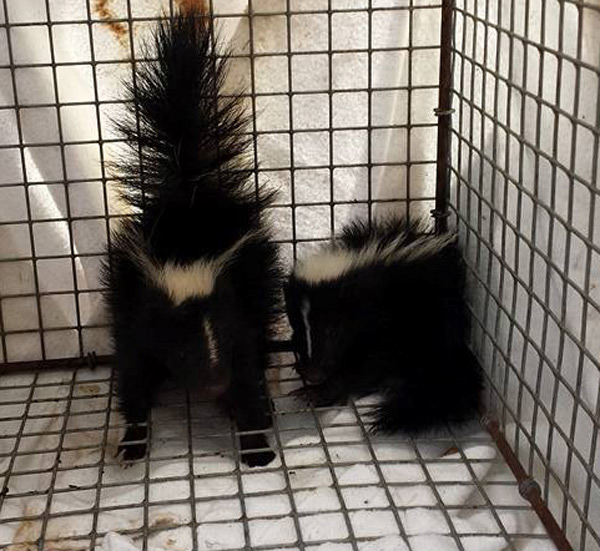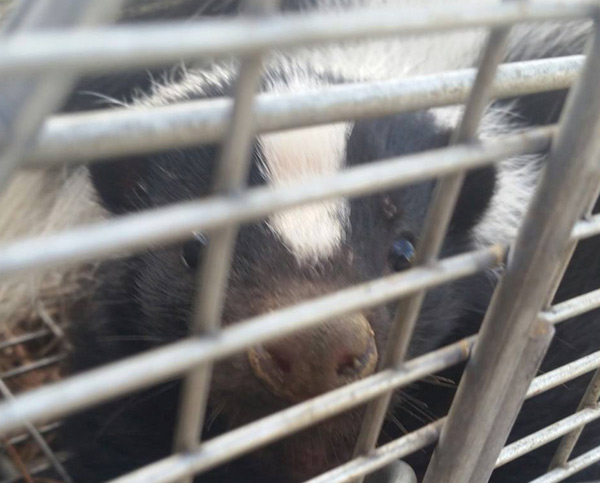- info@wildlife-removal.com
Call us for help in your town
Wildlife Removal Education
How to Get Rid of Skunks - Tips
Need skunk removal in your hometown? We service over 500 USA locations! Click here to hire us in your town and check prices - updated for year 2020.
Five steps to get rid of skunks:
- 1) The most effective method, by far, remains trapping and removal. Set large cage traps, baited with marshmallows or dry cat food, and catch the skunk. Relocate carefully to a new area.
- 2) To prevent skunks from living under a shed or porch, install exclusion barriers around the perimeter of the structure.
- 3) Habitat Modification and Removal of Food Sources - removing other places to live, or any food sources like garbage, pet food, or fallen fruit will help get rid of skunks.
- 4) Repellents - they are sold, but they genuinely do not work. A motion-sensitive sprayer might be the only device that helps.
- 5) Lethal measures - we highly advise against poisoning, which is illegal and usually ineffective (and dangerous to dogs and cats). But lethal traps can do the trick if you know how to use them.
If you need skunk help, click the nationwide directory of Professional Wildlife Removal Companies, and you'll find a skunk expert in your town or city.

Despite being largely easy-going and unlikely to attack humans or pets, skunks possess the very undesirable combination of being smelly and being a primary carrier of the rabies virus. They also often make a mess with garbage and in yards/farms, digging cone-shaped holes as they search for grub to eat.
Getting rid of skunks frequently requires a combination of prevention and exclusion strategies, with humane removal where the animal is already in residence. Fortunately, the prominent white and black coloration of the skunk’s coat makes it easily recognizable so that potential victims can escape its pungent and obnoxious secretion that it sprays as a defensive mechanism.
A note of caution: skunks are rarely active during the day and while the sighting of one in daytime may only be due to hunger, it may also mean that the skunk is rabid! Look out for signs like circling movements, disorientation, limb weakness, unusual boldness or unusual tameness. If any of these abnormal behaviors is observed, you must not attempt
to get rid of the skunk by yourself, but alert your local animal department, a wildlife expert, or the police department for help. In general, skunks are harmless. Read about Are Skunks Dangerous To Pets?
Habitat Modification and Removal of Food Sources
Food is the major attractant for wildlife on private properties. Keep pet food indoors and secure garbage cans if they must be outside. If possible, store your trash bins indoors at night, so their smell doesn't attract skunks.
Remove fruit that has fallen from your trees, especially those that produce nuts, berries, crabapples, or other fruits. Pick them as soon as they ripen and rake your yard as often as necessary.
Skunks don’t usually make their own shelter but use dens that have been abandoned by other wildlife. Inspect your property and block all holes and burrows. They also den in an accessible porch, sheds, decks, under elevated houses and foundations. Be sure to remove brush piles; use gravel, fencing, or plywood to seal all holes and entrance points to locations that a skunk may find suitable for a home. Do same for barns and poultry houses. While
this won't guarantee getting rid of skunks, it's the best approach for how to keep skunks away.

Skunk Live-Trapping
Where a skunk has already infiltrated your property, live skunk trapping is one of the most effective ways to get rid of it although the challenge for most people is in not wanting to get sprayed. Skunks are known to release their obnoxious spray when they feel threatened. It is however very possible to trap and remove a skunk without getting sprayed.
Ideally, skunk traps come in the form of medium to large steel cages. Use peanut butter, fish, or some other strong-smelling food as a bait inside the trap. The cages are spring-loaded to shut the door on the animal as soon as it gets lured inside. Raccoon traps are great for catching skunk too. In the alternative, it is easy to design a homemade trap by yourself, using a 30 gallon metal garbage can and a long, sturdy piece of stick to serve as a ramp. Place some cat food or fish inside the garbage can to lure the skunk and position the stick so the skunk can climb it from the ground and inside the garbage can. Once inside, it will not be able to get out and it will not spray in this confinement.
Once trapped, you must transport the animal several miles away from your property, preferably in a woody area. Get informed and take all necessary precautions before releasing the now agitated skunk at this location. You must also avail yourself of the local wildlife regulations in your area before you attempt to trap and relocate a skunk.
Read more about how to trap a skunk.
Skunk Repellents
Many homeowners set a lot of stock by repellent substances – while wildlife experts insist that habitat modification and removal are the only effective ways of losing these animals, several repellent substances are available commercially for preventing skunk.
It is common to see predator urine-based chemical solutions in stores. Most of these are based on fox and dog urine as they are major predators of the skunk. These products come in liquid or granule form and may require mixing with other ingredients. However, these predator urine-based products do not exactly have a great track record in repelling skunk.
If you can source it, straight dog urine has a slightly better chance. Other repellents include pepper spray, ammonia, bright lights, motion-detector sprays, and even orange peels. The best way to get rid of skunks remains trapping and removal. Click here to read more about skunk repellent
Lethal Measures
Shooting, poisoning, and lethal traps are some of the ways that people kill skunks. This is the approach some people take when tasked with how to get rid of skunks. The major challenge with killing, is how to avoid being sprayed. Skunks almost always spray when they are killed.
However, it is really not necessary to kill skunks, plus it is generally not a good idea because of the stink that will follow. The best method still remains to live trap the skunk and relocate it somewhere else. If you take the necessary precautions, you will never get sprayed while doing this.
Also read:
About Skunks: Biology Information
Do Skunks Attack Pets?
Do mothballs and ammonia help repel skunks?
What should I do with a skunk after I catch it?
Can Skunks Climb Fences?
Do Skunks Hibernate During the Winter?
Can Skunks Swim?
Is It Legal To Trap A Skunk?
Can Skunks Climb Trees or Fences?
How Can Skunks Damage Under Your House?
Will A Skunk Have a Nest of Babies Under a Shed or Porch?
Best Ways To Remove Skunks From Under Your Shed or Porch
For more information on how to get rid of skunks, go to my skunk removal information page.
What are some ways to get rid of a skunk in the yard?
There are several ways to get rid of a skunk in your yard, and the two major considerations that you need to manage while carrying out the act is how to avoid being sprayed and how to get it done in a humane way. Not getting sprayed could be a dilemma because skunks almost always spray when they are killed. However, it is quite possible to achieve this feat without getting sprayed in return.

When you have a skunk constituting nuisance in your yard, the best ways to kill it is either to shoot at it or to live-trap it and then euthanize.
Shooting
The option of shooting a skunk is more suited to rural dwellers due to the associated risk of shooting persons and pets by mistake in urban and suburban areas. Shooting a skunk seems simple enough, but the matter of the animal’s blood needs to be well considered. It may have been contaminated with rabies and other zoonotic infections and these diseases are transferable to humans that are exposed to the blood of rabid animals.
Get as close as possible to the skunk before shooting; close range is best for a clean shot and a quick, humane death
By Euthanization
Euthanization is the method of choice with animal control departments and other humane societies. It is also called ‘putting the animal to sleep’. After the skunk must have been trapped, it gets injected with sodium pentobarbital so that its death can be painless. The injection may be administered by a long, extendable syringe to avoid getting sprayed in return.
Care should always be taken to guarantee the animal is euthanized humanely. As an alternative to doing it yourself, you may contact your local wildlife control company, veterinarian, animal shelter. They may euthanize the animal for a fee.
Lethal Traps
Body grip traps are a kind of lethal trap, almost only used by old time fur trappers. They are both difficult and dangerous to use. The most common is the double spring-loaded connibear trap. They work by snapping down on the animal when sprung, and killing it via choking or squeezing. The use of lethal traps are inhumane and mostly impractical because they pose a danger to neighborhood dogs and cats. Dealing with the carcass is also not a pleasant affair. Lethal traps are banned in some states


















